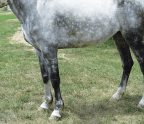GREAT HORSES BY DESIGN



Upon his father’s death in 1932, Robert J. Kleberg, Jr. became manager of King Ranch and was named its president three years later when it was incorporated. For the next 50 years, “Mr. Bob” was the prime mover behind King Ranch horse and cattle breeding programs and he deserves major credit for designing a scientific and highly effective breeding system.
Gritty, persistent, indomitable and highly knowledgeable, Kleberg famously summed up his philosophy when he told his daughter, “You must have a dream first. Then work like hell to make it come true.” The King Ranch program contains valuable lessons for anyone interested in breeding horses, whether their operation is large or small.
As King Ranch enterprises grew to become multi national after 1940, Bob Kleberg’s nephew Richard Kleberg, Jr. (“Mr. Dick”), took over most aspects of running the Quarter Horse breeding program. Taking full advantage of enormous resources in terms of money, quality breeding stock, acreage and manpower, the Klebergs were able to “fix” the type of the horses and cattle bred on the King Ranch in a remarkably short span of time. According to breed historian Robert Denhardt, they would have gone on to establish a unique King Ranch horse breed had it not been for the incorporation of the American Quarter Horse Association (AQHA) in 1940, just as the breeding program Bob Kleberg had started in 1921 was coming to fruition. The Klebergs’ reasons for throwing in with the association instead of carrying on independently were both financially wise and, as we will see, highly laudable in terms of the long-term benefit to the breed.
THE OLD SORREL
The Old Sorrel is the foundational King Ranch Quarter Horse stallion, but he did not enter the picture immediately. As early as 1854, ranch founder Captain Richard King began buying good “American” horses (bred east of the Mississippi) and bred them for both sale and use on the ranch. When the U.S. Government remount breeding program came into existence in the first decades of the 20th century, his successor and son-in-law, Robert Kleberg, Sr., took advantage of the opportunity to introduce some quality Thoroughbred blood. Thus from its earliest days, King Ranch cowboys had ridden a mixture of types including Cayuses, Mustangs, part-Thoroughbreds, Morgans and Mountain Horses (the ancestors of American Saddlebreds in the same way that the Billy-Rondo is the ancestor of the Quarter Horse; see “Mountain Horses: America’s Hidden Treasure,” EQUUS 489). Derived from colonial-era easy-gaited Thoroughbreds, Mountain Horses were known for toughness and stamina and were widely used for ranch work (see “America’s Major Horse Breeds Emerge,” EQUUS 473). Kleberg, like King before him, was after size, strength, easy saddling qualities, soundness, handsome appearance, good-mindedness and smooth gaits.
Sometime about 1910, however, the senior Mr. Kleberg discovered Billys. Neighbor George
You’re reading a preview, subscribe to read more.
Start your free 30 days



